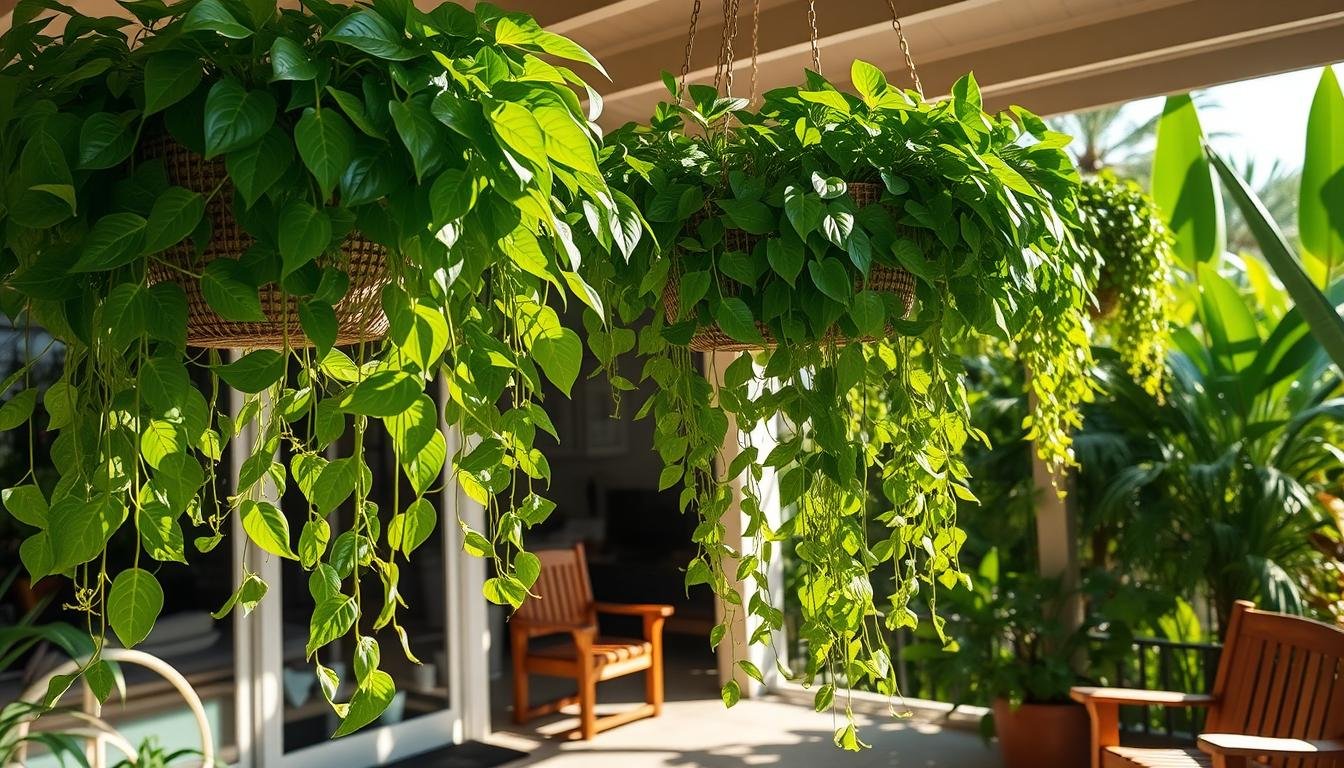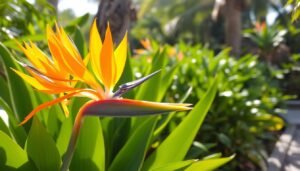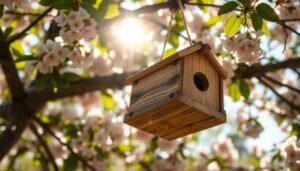Thinking of making your outdoor space better? Can I plant my pothos on my lanai is a great question, and the answer is yes! Known as Epipremnum aureum, these plants are loved for their hardiness and beautiful leaves, thriving in various lighting conditions, perfect for shaded areas like your lanai.
Pothos add natural beauty to warm spaces, especially in USDA zones 10-12. However, it’s essential to remember that pothos can be toxic to humans and pets if ingested, so plant with care.
Gardening responsibly is key, particularly with plants like pothos that can spread easily. This guide will explore can I plant my pothos on my lanai, offering care tips and guidance to turn your lanai into a lush green oasis.
Key Takeaways
- Pothos thrive in warm temperatures between 70° and 90°F.
- Protect pothos when temperatures fall below 50°F.
- Popular types include ‘Golden Pothos’ and ‘Marble Queen’.
- Soil that drains well is key for healthy roots.
- Pothos can be mildly toxic to humans and pets if eaten.
- They’re easy to grow from stem cuttings.
Table of Contents
The Ideal Trailing Vine for Your Lanai
Pothos plants are loved for their beautiful vines and easy care. They come from Southeast Asia and can live in many places. This makes them great for lanai gardens.
They do well in low light, perfect for shaded spots. This lets everyone enjoy their bright leaves.
Pothos leaves come in many colors and patterns. I like the green, golden-yellow, and marbled ones. They add beauty and shade tolerance to any space.
It’s easy to grow more pothos by cutting stems. Just put the cuttings in water until roots grow. Keep the temperature between 60°F and 80°F for best growth.
They like slightly acidic soil, with a pH of 6.1 to 6.5. This helps them grow well.
Pothos vines can grow 6-10 feet indoors and up to 30-50 feet outside. Water them when the top inch of soil is dry. Fertilize every 1-3 months to keep them healthy and green.
| Characteristics | Details |
|---|---|
| Growing Regions | USDA Zones 10-12, particularly in frost-free areas like Florida and California |
| Toxicity Level | Mildly to moderately poisonous if ingested by pets or children |
| Growth Rate | Slow to fast, depending on the variety; variegated leaves may slow growth |
| Maximum Length | 6-10 feet indoors; up to 30-50 feet in native habitat |
| Recommended Temperature | Above 50°F; ideal range is 60-80°F |
| Ideal Soil pH | 6.1 to 6.5, but tolerant of slightly acidic or alkaline conditions |
Pothos plants are perfect for both inside and outside. They make spaces look better and improve air quality. Adding them to your lanai brings nature’s beauty to your home.
Can I Plant My Pothos on My Lanai?
I often wonder if I can plant my pothos on my lanai. This spot has special conditions that help pothos grow well. The partial shade keeps plants safe from too much sun.
It also protects them from bad weather. This makes a stable place for these plants to thrive.
While I can plant pothos outside, I must be careful. Pothos can spread too much in some places. It’s also bad for pets, so I keep them away.
Container gardening is a good choice. It lets me control my plants better. I can move them as the seasons change.
Pothos looks great in containers on my lanai. It adds beauty and is easy to care for. I can move the pots to get more sun or hide from bad weather.
| Consideration | Details |
|---|---|
| Shade Requirement | Partial shade is ideal for pothos. |
| Weather Protection | Lanai offers protection from harsh weather, stabilizing conditions. |
| Invasiveness | Pothos can become invasive if planted directly in the ground. |
| Pet Safety | Pothos is toxic to pets; container gardening mitigates this risk. |
| Mobility | Container gardening allows for easy relocation of plants. |
| Aesthetics | Pothos enhances the beauty of patio plants when displayed in containers. |
Best Conditions for Pothos Growth on Your Lanai
Pothos is a favorite in the tropical plants family. It does best in certain conditions. Knowing these helps me keep my pothos care top-notch, making the plant look great.
Pothos loves moderate to bright, indirect light. Too much direct sun can burn the leaves and harm the plant.
Temperature is key for pothos. Keeping it around room temperature, between 70 and 90 degrees Fahrenheit, is best. This matches where pothos plants naturally live, in Southeast Asia and the western Pacific.
Humidity matters too. Pothos likes it more humid. I use misting or pebble trays to keep it right. Keeping humidity at 50-70% helps my pothos grow strong.
Soil type is also important. Pothos does well in many soils. I choose a mix that holds moisture but drains quickly.
Watering is crucial. I make sure the soil is moist but not too wet. Letting the top two inches dry out before watering again is key. From March to September, I use a liquid fertilizer at half strength to help it grow.
With the right conditions, my pothos can grow long and beautiful. As a beginner, knowing these basics helps my plant thrive. Proper lighting, temperature, humidity, and watering keep my pothos healthy and vibrant.
| Condition | Ideal Level | Notes |
|---|---|---|
| Light | Moderate to Bright Indirect | Avoid direct sunlight to prevent leaf scorch. |
| Temperature | 70-90°F (21-32°C) | Room temperature mimics native conditions. |
| Humidity | 50-70% | Misting and pebble trays enhance moisture. |
| Watering | Weekly | Allow top 2 inches to dry out between waterings. |
| Fertilization | March to September | Use liquid fertilizer at half strength. |
Pothos Varieties Perfect for Lanai Gardening
Looking for the best pothos varieties for your lanai? I’ve found a few that really shine. They love tropical weather and do great indoors too. Let’s take a closer look at some top picks.
- Golden Pothos: This one has beautiful green and yellow leaves. It loves low light and is great for cleaning the air. It’s a favorite for its looks and health perks.
- Marble Queen: Its leaves are a mix of white and green, looking like marble. It likes bright light but can handle less. It’s perfect for different lanai spots.
- Neon Pothos: Known for its bright lime color, it’s really eye-catching. It brings color to any room and does well outside in moist soil.
These pothos varieties are great for tropical plant fans. They look good with other indoor plants in big pots. Big pots keep the soil moist, so they don’t dry out as fast. They’re also tough, so they can handle if you forget to water them sometimes.
Choosing the Right Container for Pothos
When starting container gardening with pothos, picking the right pot is key. Make sure the pot has holes for water to drain. This stops root rot, a big problem that slows growth.
Use a mix that drains well and add things like perlite or orchid bark. These help with air and water flow.
The size and material of the pot matter a lot. A bigger pot helps roots grow and keeps moisture in, which is good in hot weather. Ceramic or plastic pots keep soil warm, which pothos like.
Pothos do best in 65°F to 85°F (18°C-30°C) temperatures. So, choose a pot that keeps the soil at the right temperature.
For looks, mix different pot sizes and shapes. Pots that need the same light look good together. Pothos love bright, indirect light. Place your pots where they get the best light.
For more tips on container gardening and using houseplants outside, check out this resource. The right pot makes your pothos happy and your outdoor space greener.
| Container Material | Benefits | Common Size Recommendations |
|---|---|---|
| Ceramic | Durable, attractive, retains moisture well | 8-12 inches in diameter |
| Plastic | Lightweight, affordable, available in many colors | 10-14 inches in diameter |
| Fabric | Good aeration, promotes healthy root growth | 12-16 inches in diameter |
Pothos Care: Watering and Light Requirements
Pothos care is all about knowing the water and light needs of this tough plant. It comes from tropical places and does well when it gets what it needs. The right amount of water and light make it grow strong and green.
Understanding Water and Light Needs
I wait until the soil is dry before watering my Pothos. This stops signs of overwatering like yellow leaves and rot. I water it every one to two weeks, but it changes with my room’s humidity and temperature.
Pothos loves bright, indirect light. Too much sun can burn its leaves, and too little slows it down. A spot with filtered sunlight is perfect for vibrant colors and health.
Signs of Overwatering and Underwatering
Spotting signs of overwatering is key to saving your Pothos. Look for wilting, yellow leaves, and a musty smell. If I see these, I let the soil dry out before watering again.
Underwatering is a problem too, causing droopy leaves and dry edges. A good soaking can fix it. I check the top inch of soil often to adjust my watering.
| Watering Tips | Light Requirements |
|---|---|
| Water only when the top inch of soil is dry. | Bright, indirect sunlight is ideal. |
| Use pots with drainage holes to prevent root rot. | Avoid placing in direct sunlight to prevent leaf scorch. |
| Adjust frequency based on temperature and humidity. | Low-light conditions can be tolerated but will slow growth. |
Soil and Planting Mixes for Pothos
Success in container gardening starts with the right soil for pothos. A well-draining potting mix is key for these plants. Pothos do well when their roots can breathe and don’t sit in water.
I suggest mixing potting soil, perlite, and peat for the best balance. Perlite or vermiculite helps prevent waterlogging and root rot. This is because they improve drainage.
The pH level of the soil is also important. For pothos, the ideal pH is slightly acidic, between 6.1 and 6.5. This pH helps them absorb nutrients well, leading to healthy growth and beautiful leaves.
Different planting mixes meet different needs. Here are some popular ones:
| Mix Type | Key Ingredients | Benefits |
|---|---|---|
| Basic Potting Mix | Peat, perlite, and vermiculite | Good drainage, holds moisture |
| Coco Coir Mix | Coco coir, perlite, and compost | Environmentally friendly, retains moisture |
| Succulent Mix | Sand, gritty soil, and gravel | Excellent drainage for overwatering prevention |
In container gardening, let the top inch or two of soil for pothos dry out before watering. This keeps the right moisture level and prevents unhealthy conditions. By choosing the right soil mix and caring for your pothos, you’ll create a perfect environment for growth and beauty on your lanai.
Common Pests and Diseases Affecting Pothos Plants

Pothos plants are usually tough but can get sick. Knowing the signs of pests and diseases is key. This helps keep your plants healthy and looking good.
Identifying and Managing Pests
Some pests that bother pothos are:
- Mealybugs
- Spider mites
- Aphids
To fight these pests, I use natural methods like:
- Insecticidal soap
- Neem oil
These methods are safe and work well. Checking my plants often helps me catch pests early. This way, I can stop them before they cause too much harm.
Preventing Diseases Through Proper Care
Pothos can get sick in many ways, like:
- Phytophthora root rot, from bad cuttings
- Bacterial wilt disease, in the early stages
- Rhizoctonia blight, from the soil
- Southern blight, common in warm places
To avoid these sicknesses, I focus on good care. This includes:
- Keeping things clean
- Ensuring pots drain well
- Not crowding plants, to stop disease spread
Using fungicides like aluminum tris or phosphorous acid helps too. Being careful and taking good care of my plants keeps them healthy. This way, I can enjoy my pothos without worrying about pests and diseases.
| Pests/Diseases | Signs | Treatment |
|---|---|---|
| Mealybugs | White, cotton-like substance on leaves | Insecticidal soap or neem oil |
| Spider mites | Webbing and stippling on leaves | Thoroughly spraying with water or neem oil |
| Phytophthora root rot | Wilting, yellowing leaves, and rotten roots | Improve drainage and use appropriate fungicides |
| Bacterial wilt disease | Leaves wilt quickly, plant stunts | Remove infected plants, sanitize tools |
| Rhizoctonia blight | Dark, water-soaked lesions on leaves | Maintain good soil health, use fungicides |
Conclusion
As we finish this guide on planting pothos on my lanai, it’s clear pothos are a great choice. They add beauty to any tropical garden and are easy to care for. Their green leaves and vines make your outdoor space more inviting and peaceful.
Pothos love bright, indirect light and temperatures between 65°F and 85°F. They need regular pothos care. Water them when the top inch of soil is dry. Fertilize every 4-6 weeks when they’re growing. Watch for humidity and pests to keep your plants healthy.
Now you know how to make your pothos thrive on your lanai. Prune and repot them regularly. Choose the right pot and soil. With these tips, your pothos will stay green and healthy all year. Happy gardening!




